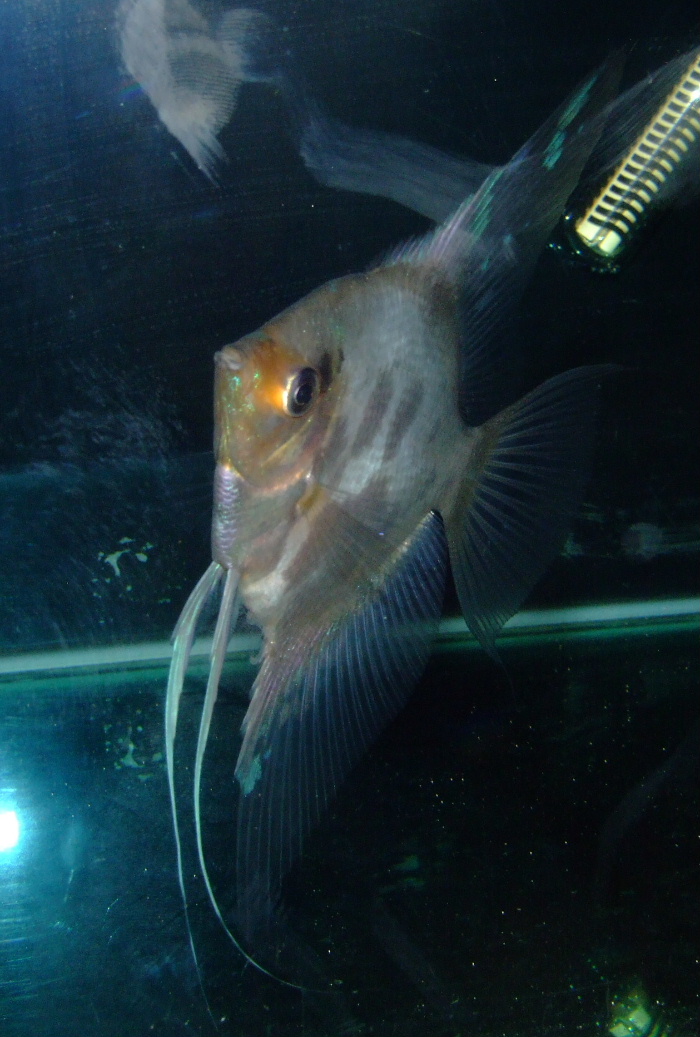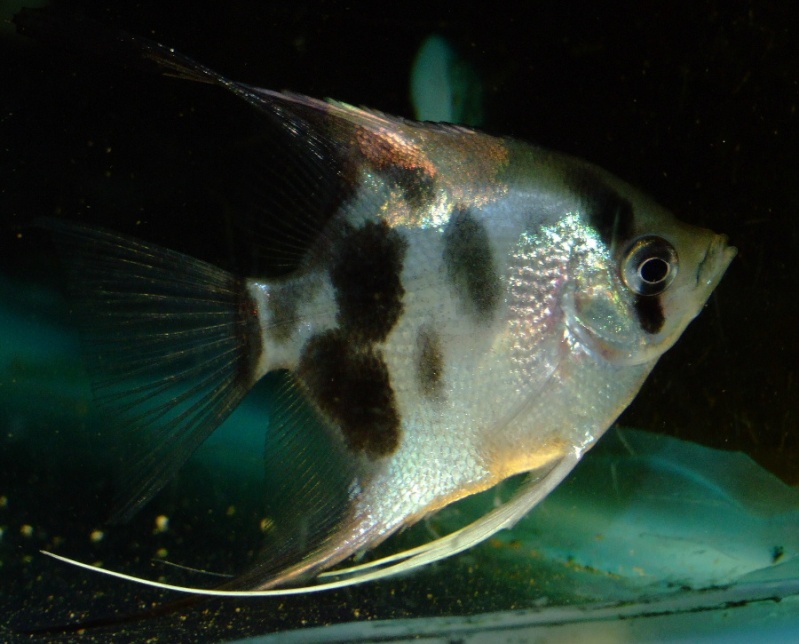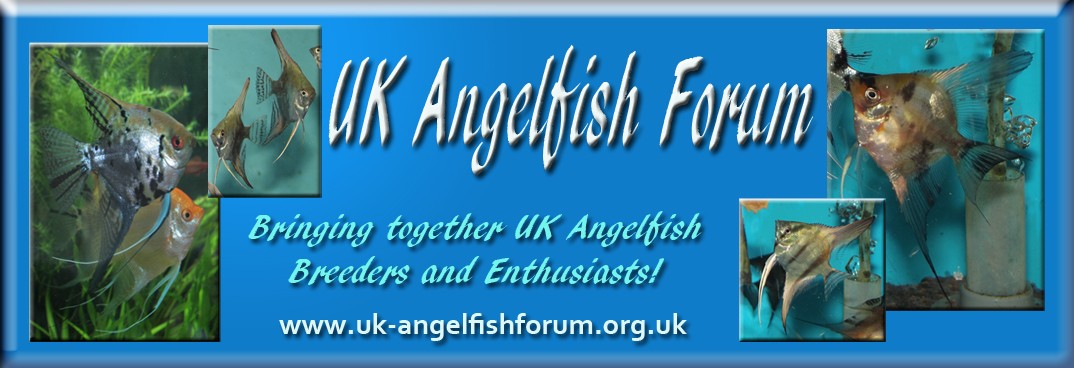Latest topics


A Few Angelfish images
4 posters
Page 1 of 1
 A Few Angelfish images
A Few Angelfish images
was lookinmg through my computer files & found a load of images I had taken of Johns fish a year or two ago:


Will post more over the next few weeks. Lisa


Will post more over the next few weeks. Lisa

Ghipsi- Admin
- Posts : 561
Join date : 2012-02-06
Age : 52
Location : North Wales UK
 Re: A Few Angelfish images
Re: A Few Angelfish images
Great pics with all those fry. I'll be looking forward to seeing more of John's beauties.

endlessendlers- Moderator
- Posts : 537
Join date : 2012-02-09
Age : 57
Location : Cardiff, Wales
 Re: A Few Angelfish images
Re: A Few Angelfish images
Very interesting....
I know there has been some debate about John's fish, but I'd be very confident in declaring that one pb/pb.
The distribution of blue irridescence on the body is absolutely typical of a paraiba. But what's very noticable are the horizontal tail markings which follow the rays, midway between the root and end of the tail. The interesting point is that these are a good indicator of pb/pb fish, but whilst they are usually present in non blushing fish, none of my paraibas have them that clearly, indeed some of my paraibas don't have them at all!
Look at these two photos for comparison....
This smokey ghost shows the tail pattern clearly

By comparison the paraiba in front in this photo doesn't have them at all, whilst the one behind shows a few, much shorter streaks

I'm assuming that John's fish is a pinoy paraiba, it is lighter than I'd expect a pinoy to be and it has a slight red caste to it's body colour. I believe some of John's fish have Czech red fish in their ancestry, and my hunch is that the key to the unusual expression shown by some of his fish, lies not with the pb gene, but with the stripeless gene that came from those Czech fish.
I know there has been some debate about John's fish, but I'd be very confident in declaring that one pb/pb.
The distribution of blue irridescence on the body is absolutely typical of a paraiba. But what's very noticable are the horizontal tail markings which follow the rays, midway between the root and end of the tail. The interesting point is that these are a good indicator of pb/pb fish, but whilst they are usually present in non blushing fish, none of my paraibas have them that clearly, indeed some of my paraibas don't have them at all!
Look at these two photos for comparison....
This smokey ghost shows the tail pattern clearly

By comparison the paraiba in front in this photo doesn't have them at all, whilst the one behind shows a few, much shorter streaks

I'm assuming that John's fish is a pinoy paraiba, it is lighter than I'd expect a pinoy to be and it has a slight red caste to it's body colour. I believe some of John's fish have Czech red fish in their ancestry, and my hunch is that the key to the unusual expression shown by some of his fish, lies not with the pb gene, but with the stripeless gene that came from those Czech fish.

Pterophyllum- Posts : 1554
Join date : 2012-02-08
Location : Gloucestershire
 Re: A Few Angelfish images
Re: A Few Angelfish images
The blushing Clown genes run through many of Johns lines  , I will post some of them next.
, I will post some of them next.
Lisa
Lisa

Ghipsi- Admin
- Posts : 561
Join date : 2012-02-06
Age : 52
Location : North Wales UK
 Re: A Few Angelfish images
Re: A Few Angelfish images
Great pictures, cracking looking fish

kim554x- Posts : 41
Join date : 2012-02-14
Age : 70
Location : Plymouth
 Re: A Few Angelfish images
Re: A Few Angelfish images
Will post more over the next few weeks.
I will post some of them next.
Please don't keep us waiting!

Pterophyllum- Posts : 1554
Join date : 2012-02-08
Location : Gloucestershire
 Re: A Few Angelfish images
Re: A Few Angelfish images
OK, Johns Blushing Clowns:























Ghipsi- Admin
- Posts : 561
Join date : 2012-02-06
Age : 52
Location : North Wales UK
 Re: A Few Angelfish images
Re: A Few Angelfish images
Absolutely gorgeous! If any of my fish from his paraibas turn out half as good as those, I'll be well pleased!

endlessendlers- Moderator
- Posts : 537
Join date : 2012-02-09
Age : 57
Location : Cardiff, Wales
 Re: A Few Angelfish images
Re: A Few Angelfish images
Hi Lisa,
Thanks for posting those,
With the first fish, there is no doubt in my mind that that is pb/pb and since it's blushing it is therefore a paraiba. It's also fair to say that there is nothing unusual in a blushing fish having the odd black mark. The same also applies to ghost angels with a single stripeless gene, some have few if any marks, whilst others can have quite extensive coverage. So whilst the black markings on that fish are unusual, they are not too out of the ordinary. It is much more unusual to see the amount of black patches seen in the fish in the third photo. At first glance, one possible explanation might be that the fish are Gm/+ rather than +/+ or +/g, however that falls down for two reasons, firstly the black marks from the Gm gene are usually darker, less rounded and most significantly don't fade with mood. The last photo appears to be of the first fish, with his patches much more faded.
Another possible explanation is to do with lighting, varying the intensity and duration of lighting under which angelfish are raised has been shown to affect stripe formation in nomal silvers, I suspect it may have some influence on the pattern development in other varieties. However, personally don't think it's a major factor here.
To my eyes, the appearence of the remaining fish is very reminiscent of the markings I had on my Czech reds, once their colour had faded, I'll try and dig out some photos later.
What I would be interested to know, is do you have any idea if any of the fish, other than #1 were thought to be paraibas? - to my eyes, all the rest look markedly different to "number 1"
Thanks for posting those,
With the first fish, there is no doubt in my mind that that is pb/pb and since it's blushing it is therefore a paraiba. It's also fair to say that there is nothing unusual in a blushing fish having the odd black mark. The same also applies to ghost angels with a single stripeless gene, some have few if any marks, whilst others can have quite extensive coverage. So whilst the black markings on that fish are unusual, they are not too out of the ordinary. It is much more unusual to see the amount of black patches seen in the fish in the third photo. At first glance, one possible explanation might be that the fish are Gm/+ rather than +/+ or +/g, however that falls down for two reasons, firstly the black marks from the Gm gene are usually darker, less rounded and most significantly don't fade with mood. The last photo appears to be of the first fish, with his patches much more faded.
Another possible explanation is to do with lighting, varying the intensity and duration of lighting under which angelfish are raised has been shown to affect stripe formation in nomal silvers, I suspect it may have some influence on the pattern development in other varieties. However, personally don't think it's a major factor here.
To my eyes, the appearence of the remaining fish is very reminiscent of the markings I had on my Czech reds, once their colour had faded, I'll try and dig out some photos later.
What I would be interested to know, is do you have any idea if any of the fish, other than #1 were thought to be paraibas? - to my eyes, all the rest look markedly different to "number 1"

Pterophyllum- Posts : 1554
Join date : 2012-02-08
Location : Gloucestershire
 Re: A Few Angelfish images
Re: A Few Angelfish images
From Chatting to John what I gather is that 1 Czec Red was bred with a koi, 7 of the resulting fry were then bred throuout Johns stock resulting in black markings that fade with mood in various blushing fish.
I will have to ask John if he has any images of any more paraiba with these 'mood' markings.
The images above were taken in may 2010. And I have noticed a number of these markings in my Blue Koi which are derived from Johns lines.
I will have to ask John if he has any images of any more paraiba with these 'mood' markings.
The images above were taken in may 2010. And I have noticed a number of these markings in my Blue Koi which are derived from Johns lines.

Ghipsi- Admin
- Posts : 561
Join date : 2012-02-06
Age : 52
Location : North Wales UK
 Re: A Few Angelfish images
Re: A Few Angelfish images
Ghipsi wrote:From Chatting to John what I gather is that 1 Czec Red was bred with a koi, 7 of the resulting fry were then bred throuout Johns stock resulting in black markings that fade with mood in various blushing fish.
I will have to ask John if he has any images of any more paraiba with these 'mood' markings.
The images above were taken in may 2010. And I have noticed a number of these markings in my Blue Koi which are derived from Johns lines.
He also told me there is Czech red And koi in his lines which is why my pinoy smokey paraiba unusually has red colouring in her eyes.

endlessendlers- Moderator
- Posts : 537
Join date : 2012-02-09
Age : 57
Location : Cardiff, Wales
 Re: A Few Angelfish images
Re: A Few Angelfish images
OK, just a little background for anyone reading this who's not familiar with "Czech red" Angelfish.
Some suggest that the Czech red is a new colour mutation, but that the colouration fades as the fish ages.
Some suggest that it's simply a common blushing angel which has been treated in some way, I've heard suggestions that they are fed a diet very high in carotines, that they are dyed, that they are kept in water containing red food colouring, that they are treated with hormones, etc. etc.
personally I suspect that they are probably genetically different to standard blushing angels, but that they are probably chemically enhanced in some way.
Back in 2009 I got a few in to see what I could do with them, the simple answer is not much, I never saw any eggs, breeding tubes, or any sign of interest in the opposite sex. I lost the last one a month or so ago.
These photos were taken a couple of days after I got them home...
notice the blue irridescence on this one

obviously not having bred from them I can't be sure, but I don't think this irridescence is due to the pb gene, the irridescence on a paraiba is in a different league.
notice the black marks on the rear of these two, perhaps not quite as extensive as on John's fish, but very similar, and again the the blue irridescence on the second one


finally a head on shot showing the distinctive orange crown and red eyes

as expected the colour faded with time


What I'd be very interested to know is what happens when a "red blushing" is mated to a "normal blushing" if any non-blushing fish were produced that would be very interesting indeed!
Some suggest that the Czech red is a new colour mutation, but that the colouration fades as the fish ages.
Some suggest that it's simply a common blushing angel which has been treated in some way, I've heard suggestions that they are fed a diet very high in carotines, that they are dyed, that they are kept in water containing red food colouring, that they are treated with hormones, etc. etc.
personally I suspect that they are probably genetically different to standard blushing angels, but that they are probably chemically enhanced in some way.
Back in 2009 I got a few in to see what I could do with them, the simple answer is not much, I never saw any eggs, breeding tubes, or any sign of interest in the opposite sex. I lost the last one a month or so ago.
These photos were taken a couple of days after I got them home...
notice the blue irridescence on this one

obviously not having bred from them I can't be sure, but I don't think this irridescence is due to the pb gene, the irridescence on a paraiba is in a different league.
notice the black marks on the rear of these two, perhaps not quite as extensive as on John's fish, but very similar, and again the the blue irridescence on the second one


finally a head on shot showing the distinctive orange crown and red eyes

as expected the colour faded with time


What I'd be very interested to know is what happens when a "red blushing" is mated to a "normal blushing" if any non-blushing fish were produced that would be very interesting indeed!

Pterophyllum- Posts : 1554
Join date : 2012-02-08
Location : Gloucestershire
 Re: A Few Angelfish images
Re: A Few Angelfish images
What I'd be very interested to know is what happens when a "red blushing" is mated to a "normal blushing" if any non-blushing fish were produced that would be very interesting indeed!
I'm sure that John has the answer to that, I will have a chat with him tomorrow.
Lisa

Ghipsi- Admin
- Posts : 561
Join date : 2012-02-06
Age : 52
Location : North Wales UK
 Re: A Few Angelfish images
Re: A Few Angelfish images
They did loose their colour, but the last one pictured is still a very pretty fish imo.

endlessendlers- Moderator
- Posts : 537
Join date : 2012-02-09
Age : 57
Location : Cardiff, Wales
 Re: A Few Angelfish images
Re: A Few Angelfish images
They did loose their colour, but the last one pictured is still a very pretty fish imo.
Yes, I'm just rather disappointed that I didn't manage to persuade any of them to breed.
Thanks, Having mated "red blushing" to "normal blushing" it would also be interesting to know if a sibling x sibling pairing produced any non blushing fish.I'm sure that John has the answer to that, I will have a chat with him tomorrow.

Pterophyllum- Posts : 1554
Join date : 2012-02-08
Location : Gloucestershire
 Similar topics
Similar topics» Some of my Angelfish Stock available at the moment with images
» Red Devil images
» how do I post images?
» My Rams have the Blues, yes still Angel images!
» The British Cichlid Assosiation Convention and Auction is nearly here! Some lot images!!!
» Red Devil images
» how do I post images?
» My Rams have the Blues, yes still Angel images!
» The British Cichlid Assosiation Convention and Auction is nearly here! Some lot images!!!
Page 1 of 1
Permissions in this forum:
You cannot reply to topics in this forum

» Is there anybody out there?
» Which option would you choose?
» Need help theirs something wrong angelfish are acting really strange
» Hi all. =)
» Disaster has struck!!!
» Scottish Members.
» Keeping angelfish fry in the parents tank
» Just Testing